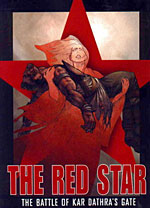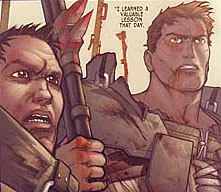>> The Book Review: The Horde
>> What About Bob? An interview with Bob Schreck, Part Two
More...

 Writers: Christian Gossett, Bradley Kayl
Writers: Christian Gossett, Bradley Kayl
Artists: Christian Gossett, AD Coulter
Colourist: Snakebite
Price: $24.95
Publisher: Image Comics
ISBN: 1-58240-197-7
THE RED STAR is one of those stories that is almost unclassifiable, by which I mean that it's impossible to categorise the book as a 'fantasy' or a 'war story' or an 'alternative history', because it manages to be all of those things and more. It's a book that is defined as much by how it is told. THE BATTLE OF KAR DATHRA'S GATE is the first story arc of the book, and serves as a prologue of sorts, but it manages to capture the feeling, philosophy and epic nature of the story.
The story is largely told through a series of flashbacks. Maya Antares tells her story to an old soldier as she visits the grave of her husband, Marcus Antares, on the anniversary of the battle. In this world, the URRS, the United Republics of the Red Star, is one of the most powerful nations on Earth. They invade the neighbouring country of Al'istaan under the guise of protecting it from "transnationalist global ambitions".
Maya narrates her own role as a 'warkaster', a sorceress whose powers are harnessed by a ship that transforms her into a pillar of energy, which is focused and used to damage enemy ships. Marcus is an infantry soldier, who is caught on the ground when the Red Star fleet is trapped by the Nistaani soldiers, whose summoning of their high priest Kar Dathra turns the tide of battle.
 Marcus finds himself trapped between life and death, caught in a battle between the Red Woman and Troika, mystical figures who engage in an awkward philosophical argument while they trade blows. It's the weakest part of the book, but the dialogue brings up the ideas that will drive the series; the struggle between individuals and the state, freedom and tyranny. The battle between these two figures over Marcus Antares' soul is the main thread of the story.
Marcus finds himself trapped between life and death, caught in a battle between the Red Woman and Troika, mystical figures who engage in an awkward philosophical argument while they trade blows. It's the weakest part of the book, but the dialogue brings up the ideas that will drive the series; the struggle between individuals and the state, freedom and tyranny. The battle between these two figures over Marcus Antares' soul is the main thread of the story.
Christian Gossett and Bradley Kayl are talented writers, but it wasn't the writing that gained the book notice in the beginning, but the artwork. Penciller Gossett, 3D artist AD Coulter, and colourist Snakebite have crafted a book that looks unlike anything else on the stands.
Beyond the beautiful pictures, incredibly detailed designs and stunning hues are a group of artists who are not just gifted, but very deliberate in their methods. Rather than adapt computer technology to tell a revolutionary story, they're consciously trying to find a new way to tell the story. Just as the book's narrative is complicated and multi-layered, so too are the visuals.
Nine pages in the beginning of the book are devoted to taking the reader through the transformation protocol and Maya's role in the battle. The sequence begins with Maya's eyes across a two-page spread as she's held in the isolation chamber. The next two pages show more port doors opening as Maya prepares for the spell, a countdown overlayed across the page alongside her narration. The page after that is a single panel that shows the sheer size of the machine that she's in, and the next makes her seem even smaller - just one of many people using their powers to pierce the hull of a nearby ship. The next two pages show the enemy ship on fire, and the final page of the sequence shows Maya exhausted by the process, while the dialogue informs her that she has just sixty seconds to prepare for the next assault.
 One could easily describe this storytelling as cinematic; across several pages, the reader is taken from the close, personal image of a pair of eyes and drawn out to witness destruction on a massive scale before returning to a variation on that first, intimate image. However, it's not really about emulating cinema, but about using the language of comics to maximum effect, exploiting the page, and combining text and pictures to convey meaning with greater effect than either can manage alone.
One could easily describe this storytelling as cinematic; across several pages, the reader is taken from the close, personal image of a pair of eyes and drawn out to witness destruction on a massive scale before returning to a variation on that first, intimate image. However, it's not really about emulating cinema, but about using the language of comics to maximum effect, exploiting the page, and combining text and pictures to convey meaning with greater effect than either can manage alone.
This is what's so exciting about the book; not its composite artwork, but how it's used in the telling of the story. This is an old-fashioned romantic epic, and true epics need real characters who are worthy of the events they are caught up in, and equal to the tasks set before them, whether required to overcome them or simply to survive them. The small moments that minor characters have in the story exemplify the kind of thought and detail that has been put into every aspect of this book. This is a huge, vast story, but that doesn't mean that details of characterisation have been sacrificed.
This is a story about political philosophy, about the importance of ideals and how such values are used and corrupted by those in power. Gossett dedicates the book to the members of the Soviet avant-garde, whose work and struggle in the early 20th century inspired the volume, and he describes their achievements better than I could. The book's bibliography is worthy of a short gasp, though really, that could describe any random two pages of this book. Every time I read this volume, I like it more. It is a truly awesome accomplishment.

This article is Ideological Freeware. The author grants permission for its reproduction and redistribution by private individuals on condition that the author and source of the article are clearly shown, no charge is made, and the whole article is reproduced intact, including this notice.


